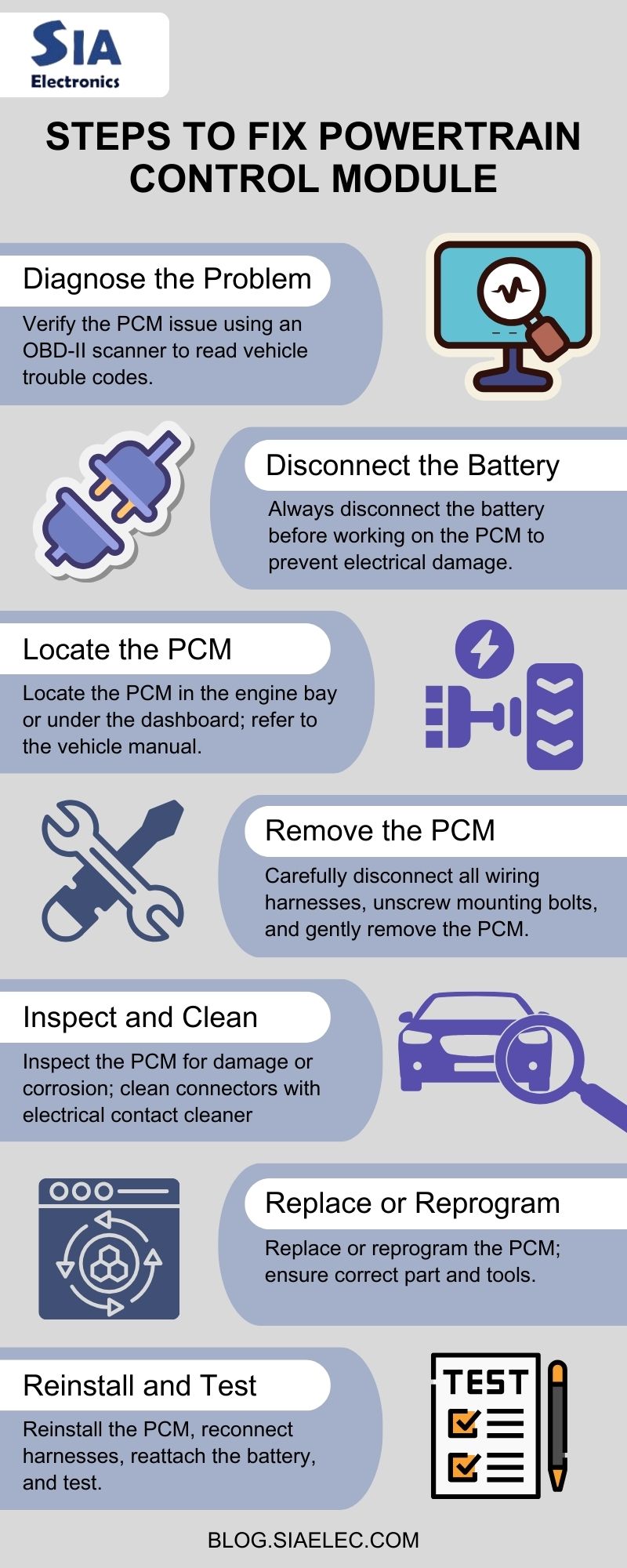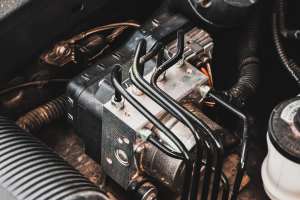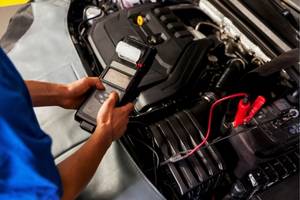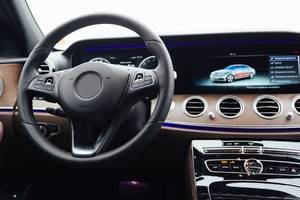Introduction
When your car's performance starts to wane, or the dreaded check engine light comes on, it might be time to check and fix the powertrain control module (PCM). But what exactly is a PCM, and how do you go about fixing it? In this guide, we will delve into the nitty-gritty of PCMs, symptoms of failure, the tools you'll need, and steps to fix it.
Table of Contents:
What is a Powertrain Control Module?
The powertrain control module (PCM) is the brain of your vehicle's engine management system. It combines the functions of the engine control unit (ECU) and the transmission control unit (TCU). The PCM oversees and regulates various functions such as fuel injection, ignition timing, and emission controls to ensure optimal engine performance and efficiency.
A functioning PCM is crucial for the overall health of your vehicle. When it fails, it can lead to numerous performance issues, impacting everything from fuel economy to drivability.
Symptoms of a Failing Powertrain Control Module
Identifying a failing PCM can save you from extensive vehicle damage. Here are some common symptoms:
- Check Engine Light: This is the most obvious sign. When the PCM detects an issue, it triggers the check engine light.
- Engine Performance Issues: Misfiring, stalling, or a rough idle could indicate PCM problems.
- Transmission Problems: Shifting issues or the transmission being stuck in a single gear can be due to a faulty PCM.
- Poor Fuel Economy: If your vehicle's fuel efficiency drops suddenly, it could be due to incorrect fuel delivery from a faulty PCM.
- Starting Issues: Difficulty starting or complete failure to start can also be a symptom of PCM failure.
Steps to Fix Powertrain Control Module
Fixing a PCM can be complex, but here’s a step-by-step guide to help you through the process:
- Diagnose the Problem
Before diving into repairs, ensure that the PCM is indeed the issue. Use an OBD-II scanner to read the trouble codes from your vehicle's system.
- Disconnect the Battery
To prevent any electrical damage, always disconnect the battery before working on the PCM.
- Locate the PCM
The PCM is usually located in the engine bay or under the dashboard. Refer to your vehicle's manual for the exact location.
- Remove the PCM
Carefully disconnect all the wiring harnesses attached to the PCM. Unscrew any mounting bolts and gently remove the PCM from its location.
- Inspect and Clean
Check for any visible damage or corrosion on the PCM and its connectors. Clean the connectors with electrical contact cleaner.
- Replace or Reprogram
Depending on the diagnosis, you might need to replace the PCM. Ensure you get the correct PCM for your vehicle model. If reprogramming is required, you might need professional help or specific tools.
- Reinstall and Test
Reinstall the PCM, reconnect all wiring harnesses, and reattach the battery. Start the vehicle and check if the issue is resolved. Use the OBD-II scanner to clear any remaining codes and verify that the PCM is functioning correctly.
Having the right tools is crucial for fixing a PCM. Here’s a list of essential tools:
- OBD-II Scanner: For diagnosing and reading trouble codes.
- Socket Set and Ratchet: For removing bolts and screws.
- Electrical Contact Cleaner: To clean connectors.
- Multimeter: To check electrical signals and continuity.
- Screwdrivers: Both flathead and Phillips for various screws.
- Replacement PCM: If a new PCM is needed, ensure it’s compatible with your vehicle.
- Service Manual: Your vehicle’s service manual for specific instructions and PCM location.
Where Can I Find Reliable Services to Fix My PCM?
Finding a reliable service to fix your PCM is crucial for ensuring quality and longevity. Here are some tips to find the best service providers:
SIA Electronics
We at SIA Electronics are industry leaders in the re-manufacturing of automotive electronic control modules and ECUs. With over 20 years of experience, we provide top-notch services for all domestic and foreign vehicles. Our services include:
- Re-manufacturing of PCMs, ECMs, and ECUs.
- Repair of mass airflow sensors.
- Fixing anti-lock brake computers (EBCMs) and hydraulic units.
Additional Tips:
- Read Reviews: Check online reviews and ratings for service providers.
- Ask for Referrals: Word of mouth can lead you to trusted service centers.
- Check Certifications: Ensure the service provider is certified and has experienced technicians.
Conclusion
A failing PCM can cause significant issues for your vehicle, but with the right knowledge and tools, you can address the problem effectively. Whether you decide to fix it yourself or seek professional help, understanding the process is crucial. At SIA Electronics, we are committed to providing reliable and high-quality services to keep your vehicle running smoothly.
FAQs on
How to Fix Powertrain Control Module in 2025 : A comprehensive guide
-
1. What is the role of the Powertrain Control Module (PCM) in a vehicle?
Ans.
The PCM acts as the brain of your vehicle's engine management system. It combines the functions of the engine control unit (ECU) and the transmission control unit (TCU), regulating essential functions like fuel injection, ignition timing, and emission controls to ensure optimal engine performance and efficiency.
-
2. How can I tell if my Powertrain Control Module is failing?
Ans.
Common signs of a failing PCM include the check engine light turning on, engine performance issues like misfiring or stalling, transmission problems, poor fuel economy, and difficulty starting the vehicle. If you experience any of these symptoms, the PCM might be the culprit.
-
3. What tools do I need to fix a Powertrain Control Module?
Ans.
Essential tools for fixing a PCM include an OBD-II scanner for diagnosing trouble codes, a socket set and ratchet for removing bolts, electrical contact cleaner for cleaning connectors, a multimeter for checking electrical signals, screwdrivers, and a replacement PCM if needed.
-
4. Can I fix a Powertrain Control Module myself, or should I seek professional help?
Ans.
Fixing a PCM can be complex and may require specific tools and expertise. While you can follow the steps for diagnosis and repair yourself, such as cleaning connectors and replacing or reprogramming the PCM, professional help is recommended for reprogramming or if you are uncertain about any part of the process.
-
5. Where can I find reliable services to fix my PCM?
Ans.
Reliable services can be found through trusted automotive electronics repair companies like SIA Electronics, which specializes in re-manufacturing and repairing automotive control modules. You should also check online reviews, ask for referrals, and ensure the service provider is certified with experienced technicians.
-
6. What should I do if my PCM needs to be replaced or reprogrammed?
Ans.
If replacement or reprogramming is required, ensure you obtain the correct PCM compatible with your vehicle model. For reprogramming, professional assistance might be necessary, as it requires specific tools and expertise. After replacement or reprogramming, reinstall the PCM, reconnect the wiring, and use an OBD-II scanner to clear any codes and verify proper functionality.



